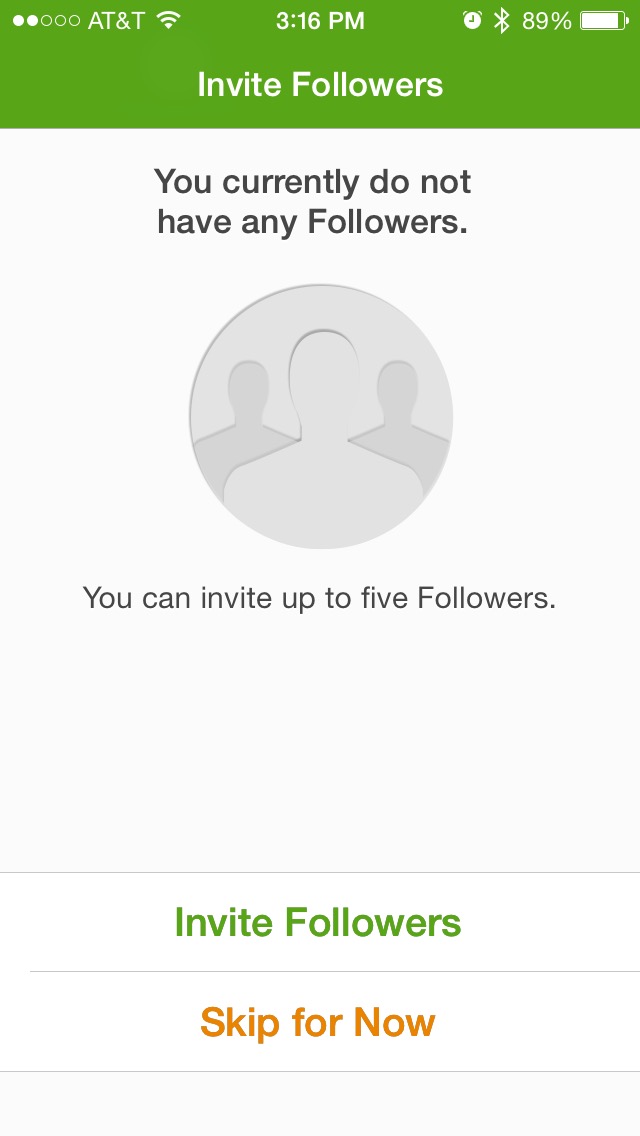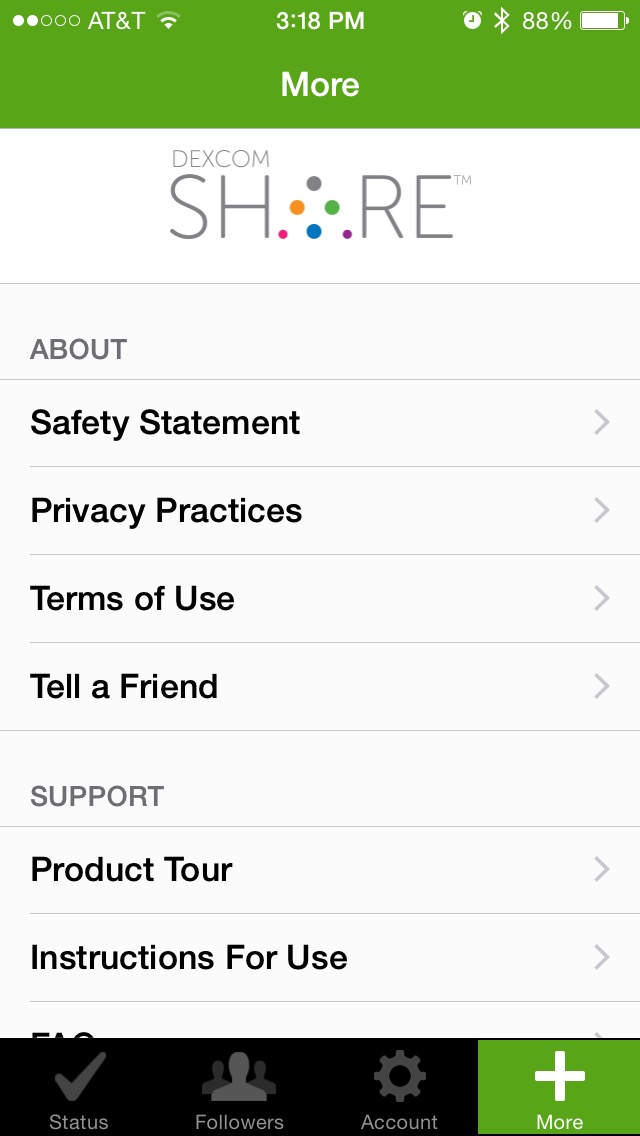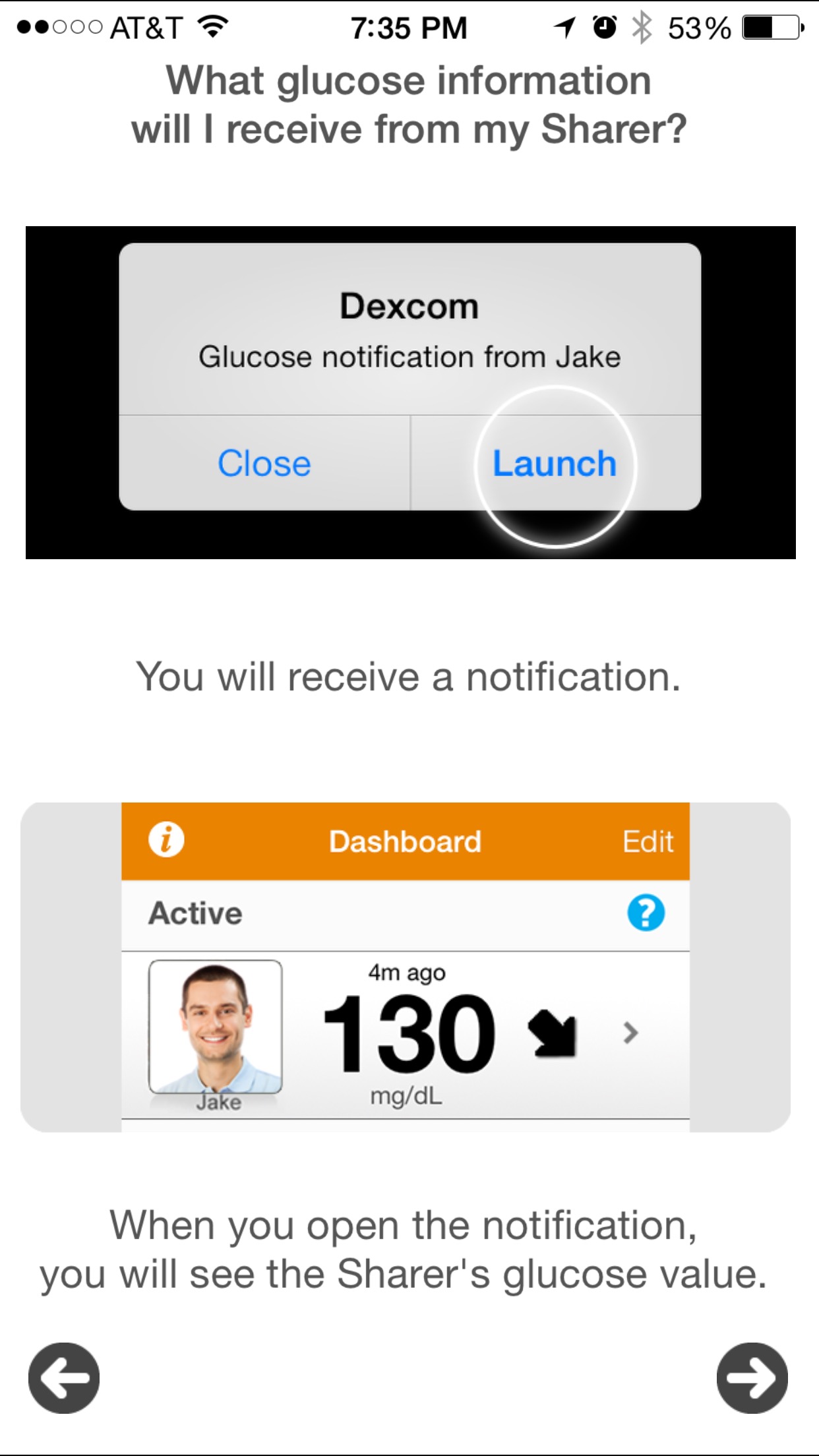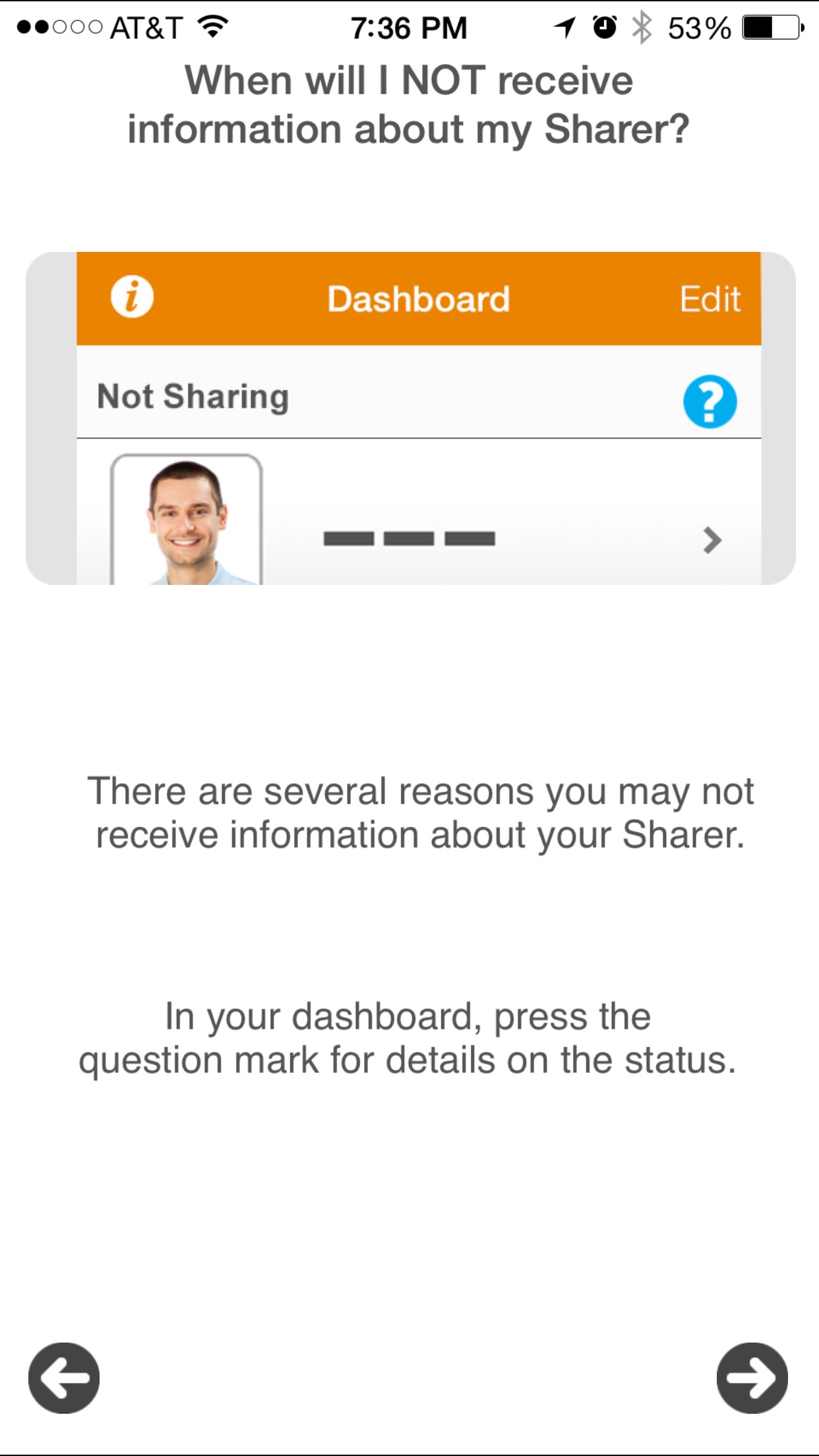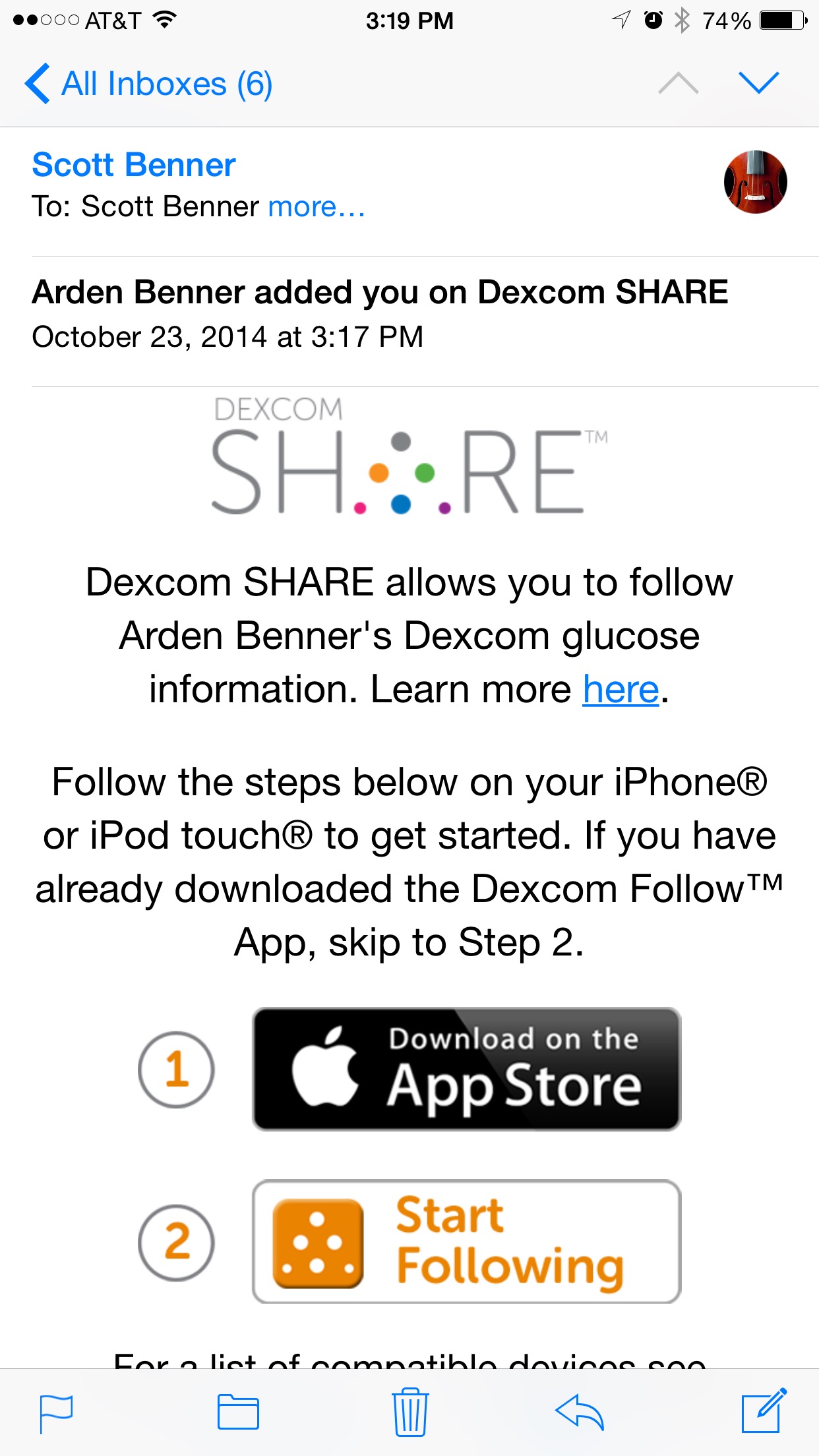First Impressions: Dexcom SHARE
I'm a bit of a pragmatist so when asked the question, "What would make the Dexcom continuous glucose monitor better?" - my simple answer was that I would like it to be able to send information to a remote location. I don't need it to power Iron Man or transform into a hover board. I just need to not have to get out of my bed and walk into Arden's room when it alerts. After eight years with type I diabetes, that is what I need more than anything else – pragmatically speaking.
It's my assumption that future iterations of CGM devices will do more. I'm hopeful that sooner rather than later, the device will be able to broadcast it's signal without the aid of a cell phone so we will be able to receive alerts on our phones or our futuristic cerebral implants without having to attach the Dex to a transmitter. But really, once cerebral implants are a reality, whose going to need a cell phone?
Back here in reality
For the moment the technology that exists has limits. First the signal from the Dexcom transmitter has to be sent to a device that can read it. The current transmitter, per the Dexcom website, has a useful distance of 20 feet.
After the transmitter sends the signal it must be captured and translated into data you can use. That's where the receiver comes in and now with the advent of SHARE, your iPhone can act as a secondary receiver.
But how does the signal get from the transmitter to your iPhone?
When Arden goes to bed she places her Dexcom receiver into the new SHARE cradle. The cradle takes the data that the receiver has gotten from the transmitter and sends it, via Bluetooth, to Arden's iPhone running the Dexcom SHARE app. That iPhone, using it's cell or a WiFi signal, sends that information to Dexcom's cloud. My iPhone running the Dexcom FOLLOW app, gets Arden's data, alarms and graphs from the cloud. It sounds convoluted I know, but it is actually very simple to set up (minutes), seamless in its execution and just plain works. In my opinion, that's when technology is helping you, when it's easy and reliable.
setup
To complete the cradle setup, plug it into the wall and pair it to your Dexcom receiver. You are finished.
To set up the transmitting iPhone (the one that needs to stay within Bluetooth distance of the cradle) download the Dexcom SHARE app from the iTunes app store.
Setting up the iPhone that you will view the data requires the Dexcom FOLLOW app.
Follow the onscreen directions to set up both apps. I've captured the SHARE and FOLLOW setup screens so you can get a look at them.
SHARE app
FOLLOW app
Using the SHARE
I use the SHARE in a few ways but mostly for sleeping hours. In my mind the device is perfect because I don't want or need it to be everywhere that Arden is. I believe that much of Arden's growth and the process of her maturing in a way that allows her to care for herself during most hours of the day, are a direct result of the situations and problem solving that is created by my not being able to constantly see her BG.
Despite what you may imagine, safety is not my first concern when I think about overnight hours and type I diabetes. Safety is important but much of the A1c success that we have is a direct result of managing overnight BGs (texting from school is a close second). These sleeping hours are free from eating and often very manageable. I monitor and manage Arden's BGs at night more with her long-term health in mind than short-term. Still, getting out of bed over and over is exhausting and why I have longed for the SHARE to come to market.
SHARE has also stopped me from having to run back and forth to Arden's room in the evenings while Kelly and I are hanging out in the living room. Big plus!
I was able to run to the store the other day in a moment that I normally wouldn't have. Arden's BG was good, stable but on the low side. I left the house confident because I could see her data. The FOLLOW app works perfectly with my cell signal.
The FOLLOW app has customizable and rather loud alarms that are difficult to ignore. They have so far woken me at night with no trouble.
Would I pay $300 for the SHARE?
In my mind, if you have the money... it's worth it just for overnights and the occasional sleepover.
Check this out!
I know that many of you want to use this technology differently than I do and so I experimented with making the cradle portable (read: without an AC outlet).
I used a portable cell phone charger that I bought on Amazon and the results were very encouraging. The cradle ran constantly, powered only by the battery source for 17 hours and 40 minutes.
If you wanted to make SHARE portable, put it in a dugout, under the bench at a basketball game, etc... you easily could but remember that you would be limited by the 20 foot restriction of the Dex transmitter.
All the rest...
- I was given this SHARE by Dexcom as a gift. You can read my disclosure of how that happened on the SHARE unboxing post
- The cradle isn't sexy but it's solidly built and will sit stably on a table top
- The Dex receiver's mini connector looks to be protected from wear and tear by the specific and tight way that the receiver is slid into the cradle
- iPhone and iPod only, "currently not available for Android"
- Cost is listed as $299 on Dexcom's site, it is not covered by insurance
- No prescription is required
- For sale in the US only
- Dexcom suggests a different cradle for each person in your home that needs the product. I'm trying to find out why from the company in more detail than their site indicates.
Tidbits directly from Dexcom
Development work is happening now for "Android, iPad and other iOS devices"
The Bluetooth low energy required for SHARE was not available on Android when the system was being developed - Dexcom is "actively working on it"
Children who have had enterovirus infection are around 50 percent more likely to have type 1 diabetes
Arden had the Coxsackievirus prior to her type I diagnosis...
from science daily.com
A new study published in Diabetologia (the journal of the European Association for the Study of Diabetes) shows that children who have been infected with enterovirus are 48% more likely to have developed type 1 diabetes. The study is by Dr Tsai Chung-Li, China Medical University, Taiwan, and colleagues.
"Type 1 diabetes is considered to be caused by complex interaction between genetic susceptibility, the immune system, and environmental factors," say the authors. "Though the cue for genetic predisposition has been elucidated, evidence also points to involvement of enterovirus (EV) infection, including viruses such as poliovirus, Coxsackievirus A, Coxsackievirus B, and echovirus."
To investigate the link between EV infection and subsequent type 1 diabetes, the researchers used nationwide population-based data from Taiwan's national health insurance system. They looked at type 1 diabetes incidence in children aged up to 18 years with or without diagnosis of EV infection during 2000-2008.
Overall incidence of type 1 diabetes was higher in the EV-infected children than in the non-EV infected group (5.73 vs. 3.89 per 100,000 people per year, showing a 48% increased incidence rate in EV-infected versus non-EV-infected children). Hazard ratios of type 1 diabetes increased with age at diagnosis of EV infection, with a more than doubling of the risk of type 1 diabetes (2.18 times increased risk) for children aged over 10 years at entry. No relationship of allergic rhinitis or bronchial asthma to type 1 diabetes was found.
The authors point out that despite countries such as Finland and Sweden having the highest incidence of type 1 diabetes worldwide, they are thought to have low background rates of enterovirus infection, suggesting that genetic factors are a large component of the high type 1 diabetes rates in those countries. But they add: "Regions such as Africa, Asia, South America have a low but increasing incidence of type 1 diabetes and high prevalence of enterovirus infection; environmental factors like enterovirus infection may play a vital role in increasing incidence in these regions."
They add: "Taiwan has relatively low type 1 diabetes incidence; we believe that the marked escalation of the said incidence in recent decades can be largely attributed to the highly endemic spread of enterovirus infection in Taiwanese children, given that there has been little gene flow and genetic drift in such a short period."
They conclude: "This nationwide retrospective cohort study found a positive correlation of type 1 diabetes with EV infection. Our results suggest that preventive strategies, such as an effective vaccine against EV infection, may lessen the incidence of type 1 diabetes in Taiwan."
The journal article referenced can be downloaded as a PDF from Diabetologia here
FDA Approves Dexcom SHARE
I just received a note from Dexcom letting me know that their long-awaited SHARE device has been approved by the FDA!
The note went on to say that Arden was nominated by a Dexcom employee to receive the device as a gift which was an absolutely wonderful surprise that, even though I've never once accepted anything free in the eight years that I've written this blog, I am happy to accept. After reading the email I immediately watched this quick video about the device and had a rather unexpected response.
I was smiling as the video played, excited to try SHARE and happy that the FDA approved the device when out of no where the voice on the video said, "Telling parents where their glucose levels are... allowing a good night's sleep". I burst into tears. I am so incredibly tired from eight years of diabetes and broken sleep that the thought of overnight relief caused me fall apart for a moment. The mere idea that I won't have to get out of bed and walk across our house to check Arden's CGM is elating. From what the video indicated the SHARE does much more but at the moment, I'm just happy be able to stay in bed. The announcement from Dexcom isn't all good news as I am left with an amazing but now unless skill. You see, I can make turns in the dark without bumping into walls by using the indicator lights on our smoke detectors as my guide. Do you have any idea how long it took me to become proficient at that?
I'll be posting an in-depth review for you as soon as possible (Dexcom did not ask me to do that, actually the only thing that I was asked to do in exchange for receiving a SHARE is complete a short survey after using the device for 30 days). My upcoming review will include a detail disclosure.
In the meantime please join me in celebrating our new lives full of unbroken sleep and unstubbed toes. I can't wait to unburden myself from the anxiety of wondering if those three beeps mean a falling BG or just a fantastically stable number that is hovering a few points below Arden's indicator threshold.
The SHARE costs $299. You can find more information, see an overview, read frequently asked questions and browse all of the details about the SHARE on Dexcom's site –
Today is good day... I'm going to go watch that video again!
10/23/14: Arden's SHARE arrived today - see the unboxing pics here!
Take the DOC Asks the FDA survey
from diaTribe.org:
Please help us tell the FDA what truly matters to patients at www.diaTribe.org/survey - this takes five minutes and will help immensely. All the feedback will help inform a November 3 patient-led meeting with FDA drug/device leadership.
from diaTribe.org:
Here's the background - On November 3, the FDA will host an unprecedented discussion between the diabetes community and senior agency leadership (both drugs and devices). The event will be live webcast from 1 - 4 pm Eastern time, and will include a panel of patients (T1 and T2), as well as representatives from JDRF, American Diabetes Association, and diaTribe. As a community, our job is to present the numerous challenges we as patients face each day, and we need as many opinions as possible to be a part of this discussion! With JDRF, ADA, and dQ&A input, we have created a survey posted at www.diaTribe.org/survey. We are asking all people with diabetes to take the survey (~5 minutes) and share thoughts on what's important when it comes to living with diabetes. This feedback will go directly to FDA and help influence the conversation on November 3. The registration info for the webcast will be posted soon.
It's Diabetes Cure Season
I remember exactly where I was and what I was doing the first time that I read about promising research to cure type I diabetes. My daughter Arden was two years old, it was early fall, just a few months after her type I diabetes diagnosis and my emotions were volatile.
I read the article with precision focus, it promised that researchers had cured type I diabetes in lab mice and told of the goal to begin human trials as soon as they could secure funding – after all, research is expensive.
I woke my wife and told her about this amazing news saying, "Arden is only going to have diabetes for a few years, they cured it in mice". I was crying uncontrollably.
That moment happened over eight years ago and since then countless lucky mice have been cured but it was only recently that I came to understand why we see so much hopeful, yet ultimately crushing news articles about diabetes cures in the fall.
It's diabetes cure season. Diabetes awareness month is November and the media; television news, newspapers and online sources pay close attention to matching their stories with the calendar, because it's what works and how things have always been done. Let me explain...
Have you ever seen me on television, heard me on the radio or read something about me that was focused on parenting and mentions my book, Life Is Short, Laundry Is Eternal: Confessions of a Stay-At-Home Dad? If you have, did you happen to notice that all of those appearances happened in early summer, you know, around Father's Day.
Maybe you read my piece about head injuries as they relate to football, the one that ran on Huffington Post three days before the Superbowl?
Producers need content and they want that content to be relevant to the calendar. People need exposer and they (me included) take it where they can get it. So whether it's a writer trying to let people know about their parenting memoir, or a researcher wanting to get wide exposer for their work so that they can attract more research dollars – if you pay close attention to the calendar, you'll see that the "news" you are being given is carefully scheduled and targeted to your emotions and the events that are about to happen in the world. The news is marketed to you to elicit clicks, shares and word of mouth.
Much of the diabetes cure research that we will hear about in the coming weeks is very promising and I am one-hundred million percent behind all of it. Please just keep in mind that is was also very promising research six months ago, but now is when you are going to read the big news, on every media outlet – all from reputable institutions.
Don't misunderstand, one of these researchers is going to figure it out and I hope that it happens soon and perhaps even is one of the methods that is being bandied about today. But when I woke up this morning to see all of you on social media feeling like I did eight years ago, it broke my heart to remember how I felt after the moment had passed and I realized that the promising lab mouse cure wasn't going to take away Arden's type I diabetes – at least not any time soon. I didn't decide to write this post until I opened up my text messages and saw that my brother also read today's cure "news" and asked me if the article was legitimate.
The answer that I owe my brother but cant bring myself to send him... that news article is legitimate but it isn't going to cure Arden now. I love you for wanting that for her and I am so sorry that these thoughts are part of your day. I wanted you and everyone reading this to understand how these news cycles work because I know how shattering it is when they turn from Diabetes Cure Found! to Thanksgiving Treats That You Can Make at Home.
Wonderful research that will one day cure type I diabetes is going on all over the world and there are a ton of good reasons to be hopeful about them, but these articles aren't going to be how we find out that a cure has been found. On the day that happens, the world will celebrate the end of diabetes with a grand spectacle, no one will have to wonder if it is legitimate.
You are all, each and every one of you, in my thoughts today.












